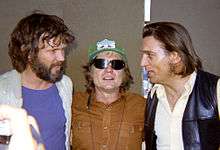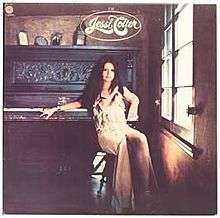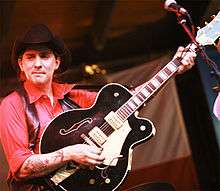Outlaw country
| Outlaw country | |
|---|---|
| Stylistic origins | |
| Cultural origins | 1960s Texas, Tennessee |
| Typical instruments | |
| Derivative forms | |
| Other topics | |
| Country musicians – List of years in country music | |

Outlaw country[1] is a subgenre of country music, most popular during the late 1960s, 1970's and early 1980's, sometimes referred to as the outlaw movement or simply outlaw music.[2][3] The focus of the movement has been on "outlaws", such as Johnny Cash, Waylon Jennings, Merle Haggard, Willie Nelson, Kris Kristofferson, and Hank Williams Jr. Other associated artists include David Allan Coe, the Eli Radish Band, Leon Russell, Townes Van Zandt, Billy Joe Shaver, Steve Earle, and Gary Stewart. The reason for the movement has been attributed to a reaction to the Nashville sound, developed by record producers like Chet Atkins who softened the raw honky tonk sound that was predominant in the music of performers like Jimmie Rodgers, and his successors such as Hank Williams, George Jones and Lefty Frizzell. According to Aaron Fox, "the fundamental opposition between law-and-order authoritarianism and the image of 'outlaw' authenticity... has structured country's discourse of masculinity since the days of Jimmie Rodgers."
History
Origins
The roots of the outlaw movement can be traced to the 1950s. A major influence on the outlaw movement was Elvis Presley's bluesy covers of country standards. However, an even greater transition occurred after Waylon Jennings was able to secure his own recording rights, and began the trend of bucking the "Nashville Sound."
David Allan Coe at the time was a patched member of the Outlaws Motorcycle Club, a notorious one percenter motorcycle club. There were several instances where he was referred to as an outlaw while playing with Willie Nelson and Waylon Jennings. Although Nashville publicly refutes claims that "outlaw country" was a term coined by Coe's involvement in the motorcycle underworld, those who thrive in the biker community both then and now believe that it was Coe who gave the music its title.
The 1960s was a decade of enormous change, and that change was also reflected in the music of the time. The Beatles, Bob Dylan, the Rolling Stones and many who followed in their wake cast off the traditional role of the recording artist. They wrote their own material, they had creative input in their albums, and they refused to conform to what society required of its youth. At the same time, country music was declining into a formulaic genre that appeared to offer the establishment what it wanted with artists such as Porter Wagoner and Dolly Parton making the kind of music that was anathema to the growing counterculture. While Nashville continued to be the focus of mainstream country music, cities like Lubbock and Austin became the creative centers of outlaw country. Southern rock also had a strong influence on the outlaw country movement, and that sound and style of recording was centered in Muscle Shoals, Alabama.
The term "outlaw country" is derived from the song "Ladies Love Outlaws" written by Lee Clayton and sung by Waylon Jennings on the 1972 album of the same name. It became associated with singers who grew their hair long, wore denim and leather and had a scruffier look in contrast to the clean cut country singers in Nudie suits that were pushing the Nashville sound, with the exception of Gram Parsons & The Flying Burrito Brothers. The success of these singers did much to restore the rawness and life force to country music. The songs were about drinking, drugs, hard working men and honky tonk heroes. The music was more like rock and roll and there were rarely strings in the background.

Development
As Southern rock flourished, veteran country artists incorporated rock into their music in this genre. Songwriters/ guitarists such as Willie Nelson, Waylon Jennings, and Hank Williams, Jr. shed formulaic Nashville sound, grew long hair, and replaced rhinestone-studded suits with leather jackets. Fiercely independent, the "outlaws" abandoned lush orchestrations, stripped the music to its country core, and added a rock sensibility to the sound. [1]
Although Jennings and Nelson are regarded as the stereotypical outlaws, there were several other writers and performers who provided the material that infused the movement with the outlaw spirit. Some people have noted that Jennings and Nelson were Nashville veterans whose careers were revived by the movement and that they drew on the energy that was being generated in their home state of Texas to spearhead the attack on the Nashville producers. Jennings, in particular, forced his record company to let him produce his own albums. In 1973 he produced Lonesome, On'ry and Mean. The theme song was written by Steve Young, a songwriter and performer who never made it in the mainstream, but whose songs helped to create the outlaw style. The follow-up album for Jennings was Honky Tonk Heroes and the songwriting hero was Texan Billy Joe Shaver. Like Steve Young, Shaver never made it big, but his 1973 album Old Five and Dimers Like Me is considered a country classic in the outlaw genre.
Willie Nelson's career as a songwriter in Nashville peaked in the late 1960s. As a songwriter, he had written a number of major pop-crossover hits, including "Crazy" for Patsy Cline and "Hello Walls" for Faron Young, but as a singer, he was getting nowhere. He left Nashville in 1971 to return to Texas. The musicians he met in Austin had been developing the folk and rock influenced country music that grew into the outlaw genre. Performing and associating with the likes of Jerry Jeff Walker, Michael Martin Murphey and Billy Joe Shaver helped shape his future career. At the same time as Nelson was reinventing himself, other significant influencers were writing and playing in Austin and Lubbock. Butch Hancock, Joe Ely and Jimmie Dale Gilmore formed The Flatlanders, a group that never sold huge numbers of albums, but continues to perform. The three founders have each made a significant contribution to the development of the outlaw genre. The Lost Gonzo Band and their work in conjunction with Jerry Jeff Walker and Michael Murphey were integral in the birth of Outlaw Country.[4]
Other Texans, like Townes Van Zandt, Steve Earle and Guy Clark, have developed the outlaw ethos through their songs and their lifestyles.
Although Johnny Cash spent most of his time in Arkansas and Tennessee, he experienced a revival of his career with the outlaw movement, especially after his live albums At Folsom Prison and At San Quentin, both of which were recorded in prisons. Cash had working relationships with Nelson, Jennings and Kris Kristofferson in his later career. He had also been on good terms with several folk counterculture figures, a fact that irked Nashville and television executives (Cash hosted a variety show from 1969 to 1971). Like the other outlaw singers, he eschewed the polished Nashville look with a somewhat ragged (especially in later years), all-black outfit that inspired Cash's nickname, the "Man in Black."
Female outlaws

Although Outlaw country was mainly the domain of men, some women pursued musical careers in Country Music, considering themselves "Outlaws" as well, including four major female outlaw stars in country music: Tanya Tucker, Jessi Colter, Sammi Smith, and Emmylou Harris.
Jessi Colter was the wife of the Outlaw pioneer Waylon Jennings. She married Jennings in 1968. In the mid-70s, she pursued a solo career, and immediately achieved Outlaw status after she scored a #1 country hit, that also reached #4 on the pop charts, titled "I'm Not Lisa", which was penned by Colter herself. Her 1975 album I'm Jessi Colter showed more of Colter's Outlaw side showing Colter in a saloon-like setting, resting her arm on a piano. Colter officially gained full-on Outlaw status when she was featured on the compilation album, along with her husband, called Wanted! The Outlaws. The album was a huge commercial and critical success and won many awards.
Another woman who achieved the Outlaw success of her male counterparts was Sammi Smith, a singer from California. Smith was unafraid to sing songs that were considered too "risky" or spoke of the realities of the modern life. Her voice was husky from singing in smoky bars before she achieved fame. Smith made it big in 1971, when she recorded Kris Kristofferson's song "Help Me Make It Through the Night." The song brought Smith to the #1 spot on the country charts, and even made her a crossover star, at #8 on the pop charts. The song won her a Grammy award in 1972 for Best Female Country Vocal Performance. She officially became an Outlaw when she moved down to Texas and became fast friends with Willie Nelson. She regularly attended his Fourth of July picnics every year.
Texas country

Newer artists, such as Robert Earl Keen Jr., Ryan Bingham, Jamey Johnson, Cory Morrow, Roger Creager, Kevin Fowler, Shooter Jennings, Wade Bowen, Jimmy Aldridge, Jesse Brand and groups such as Randy Rogers Band, Cross Canadian Ragweed, Jason Boland & the Stragglers, and Eli Young Band, who grew up during the original outlaw movement, have recently been re-energizing the Outlaw Movement and keeping with the "outlaw spirit". Also, older artists such as Ray Wylie Hubbard, Billy Joe Shaver, and David Allan Coe have also been contributing to the resurgence of the outlaw sound. Because many of these artists are native Texans or call Texas their home, it is often referred to as Texas Country. Robert Earl Keen, Pat Green, and Cory Morrow are most notably credited with bringing Texas Country out of the honky tonks and onto college campuses. Keen, a graduate of Texas A&M University, where he and fellow songwriter Lyle Lovett were roommates, has been performing on college campuses since the late 80s. Along with Green's shows in the late 90s, these artists began to increase with incredible popularity on college campuses in Texas and Oklahoma including Texas Tech, (Green's alma mater), Texas A&M, Oklahoma State University (home of the red dirt music scene) and the University of Texas. Their popularity gave more exposure to other Texas Country artists like Cory Morrow, Roger Creager, and Kevin Fowler and to groups like Cooder Graw.
In 1998, maverick record executive Rick Smith, of Fort Worth, launched the "Live at Billy Bob's Texas" series of recordings, which have featured legends such as Willie Nelson, Billy Joe Shaver, Asleep at the Wheel, Merle Haggard, David Allan Coe and popular Texas Country artists like Pat Green, Jack Ingram, Cory Morrow, Cross Canadian Ragweed (Oklahoma), Jason Boland & the Stragglers, Cooder Graw, the Randy Rogers Band and Kevin Fowler.
Other Texas based artists, such as Eleven Hundred Springs, Wayne "The Train" Hancock, Dale Watson, Stoney LaRue and Hayes Carll, continue the tradition of their Outlaw country forebears in Texas and have helped usher in the movement in honky tonks across the U.S.
Notable artists
- Daniel Antopolsky
- Bobby Bare, Sr.
- Bobby Bare, Jr.
- Scott H. Biram
- Bobby Black
- Cody Jinks
- Robert Earl Keen
- Lyle Lovett
- Country Cavaleers[5]
- Don Bowman
- Jesse Brand
- Hayes Carll
- Johnny Cash
- Rosanne Cash
- Eric Church
- Brandy Clark
- Guy Clark
- Lee Clayton
- David Allan Coe
- Jessi Colter
- Elizabeth Cook
- Rodney Crowell
- Charlie Daniels
- Justin Townes Earle
- Steve Earle
- Eli Radish Band
- Joe Ely
- Fifth on the Floor
- Jimmie Dale Gilmore
- Tompall Glaser
- Merle Haggard
- Tom McELvain
- Tom T. Hall
- Butch Hancock
- Wayne "The Train" Hancock
- Emmylou Harris
- Ray Wylie Hubbard
- Shooter Jennings
- Waylon Jennings
- Jamey Johnson
- Kris Kristofferson
- Jim Lauderdale
- James Scott Bullard[6][7]
- Lost Gonzo Band
- Matt Mason
- James McMurtry
- Jimmy Miles
- Buddy Miller
- Roger Miller
- Ashley Monroe
- Whitey Morgan and the 78's
- Michael Martin Murphey
- Kacey Musgraves
- Willie Nelson
- Gram Parsons
- Johnny Paycheck
- Casey James Putnam
- Leon Russell
- Doug Sahm
- Ray Scott
- Billy Joe Shaver
- Sturgill Simpson
- Sammi Smith
- Todd Snider
- Chris Stapleton
- Gary Stewart
- B.W. Stevenson
- Travis Tritt
- Tanya Tucker
- Cheryl Tunt
- Townes Van Zandt
- Jerry Jeff Walker
- Dale Watson
- Hank Williams, Jr.
- Hank Williams III
- Lucinda Williams
- Steve Young
- Rowdy Johnson Band
- Ronnie Dean Tinsley
See also
Notes
- 1 2 Szatmary, David P. (2014). Rockin' in Time. New Jersey: Pearson. p. 213.
- ↑ Billboard. Retrieved 5 June 2011.
- ↑ Outlaw music at Encyclopædia Britannica
- ↑ The Improbable Rise of Redneck Rock. Retrieved 31 January 2015.
- ↑ Country Entertainment USA. "Country Entertainment USA - Nashville Edition - Outlaws And Country Music, The Country Cavaleers by Brenda L. Madden". Retrieved 31 January 2015.
- ↑ "KBEC on Outlaw Country Music". Retrieved 31 January 2015.
- ↑ "Who is James Scott Bullard". Answers.com. Retrieved 31 January 2015.
Sources
- Fox, Aaron A. (2004). "White Trash Alchemies of the Abject Sublime: Country as 'Bad' Music". In Washburne, Christopher J.; Derno, Maiken (eds.). Bad Music: The Music We Love to Hate. Routledge. ISBN 0-415-94366-3.
Further reading
- Reid, Jan (2004). The Improbable Rise of Redneck Rock (New ed.). University of Texas Press. ISBN 0-292-70197-7.
- Spong, John (April 2012). "That 70’s Show". Texas Monthly (Austin, Texas). Retrieved October 26, 2013.
- Wolff, Kurt (2000). Country Music. The Rough Guide. Rough Guides. ISBN 1-85828-534-8.
External links
- Outlaw Magazine - The Outlaw Music Magazine
- Outlaw country history
- AMG essays on country music themes
- Outlaw Country Semi-Weekly Charts